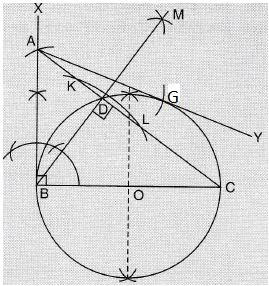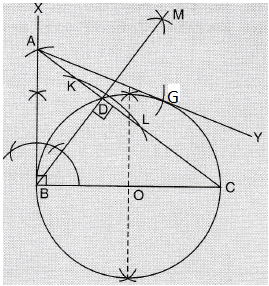To construct: A right triangle ABC with AB = 6 cm, BC = 8 cm and ∠B = 900 .BD is the perpendicular from B on AC and the tangents from A to this circle.
Follow the given steps to construct the figure.
Steps of Construction:
Step 1
Draw a line BC of 8 cm length.
Step 2
Draw BX perpendicular to BC.
Step 3
Mark an arc at the distance of 6 cm on BX. Mark it as A.
Step 4
Join A and C. Thus, ∆ABC is the required triangle.
Step 5
With B as the centre, draw an arc on AC.
Step 6
Draw the bisector of this arc and join it with B. Thus, BD is perpendicular to AC.
Step 7
Now, draw the perpendicular bisector of BD and CD. Take the point of intersection as O.
Step 8
With O as the centre and OB as the radius, draw a circle passing through points B, C and D.
Step 9
Join A and O and bisect it. Let P be the midpoint of AO.
Step 10
Taking P as the centre and PO as its radius, draw a circle which will intersect the circle at point B and G. Join A and G.
Here, AB and AG are the required tangents to the circle from A.

Justification:
The construction can be justified by proving that AG and AB are the tangents to the circle. For this, join EG.
Then, 
∠AGE is an angle in the semi-circle. We know that an angle in a semi-circle is a right angle.
∴ ∠AGE = 90°
⇒ EG ⊥ AG
Since EG is the radius of the circle, AG has to be a tangent of the circle.
Already, ∠B = 90°
⇒ AB ⊥ BE
Since BE is the radius of the circle, AB has to be a tangent of the circle.
.

